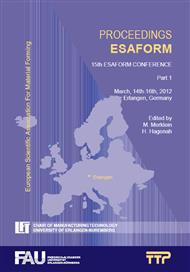p.1329
p.1335
p.1341
p.1347
p.1353
p.1359
p.1365
p.1371
p.1377
Influence of Grinding on the Surface Properties of Cemented Carbides
Abstract:
The increased demand for manifold industrial goods requires superior manufacturing techniques. In the field of steel products, cold forging has gained importance for the last sixty years. Within cold forging the tool takes a key role as it determines both accuracy and efficiency of forming process. For forming processes with high demands regarding wear resistance WC-Co cemented carbides are increasingly used as tool materials. The manufacturing process of the tool requires a combination of hard and fine machining. In order to reduce the effort of subsequent fine machining process, surfaces with low roughness are preferred. As grinding leads to high surface qualities, it is a common method in tool machining. Grinding is accompanied by compressive residual stresses in the surface which have a positive influence on the tool life. The absolute value of residual stresses is determined by the machining parameters. The present study investigates the influence of feed and in-feed on the topography and the near surface residual stresses. While the surface roughness is correlated with both parameters, the feed has a major influence on the residual stresses in the surface of cemented carbides.
Info:
Periodical:
Pages:
1353-1358
Citation:
Online since:
February 2012
Authors:
Keywords:
Price:
Сopyright:
© 2012 Trans Tech Publications Ltd. All Rights Reserved
Share:
Citation:


